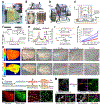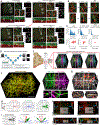Integrated platform for multiscale molecular imaging and phenotyping of the human brain
- PMID: 38870291
- PMCID: PMC11830150
- DOI: 10.1126/science.adh9979
Integrated platform for multiscale molecular imaging and phenotyping of the human brain
Abstract
Understanding cellular architectures and their connectivity is essential for interrogating system function and dysfunction. However, we lack technologies for mapping the multiscale details of individual cells and their connectivity in the human organ-scale system. We developed a platform that simultaneously extracts spatial, molecular, morphological, and connectivity information of individual cells from the same human brain. The platform includes three core elements: a vibrating microtome for ultraprecision slicing of large-scale tissues without losing cellular connectivity (MEGAtome), a polymer hydrogel-based tissue processing technology for multiplexed multiscale imaging of human organ-scale tissues (mELAST), and a computational pipeline for reconstructing three-dimensional connectivity across multiple brain slabs (UNSLICE). We applied this platform for analyzing human Alzheimer's disease pathology at multiple scales and demonstrating scalable neural connectivity mapping in the human brain.
Conflict of interest statement
Figures









